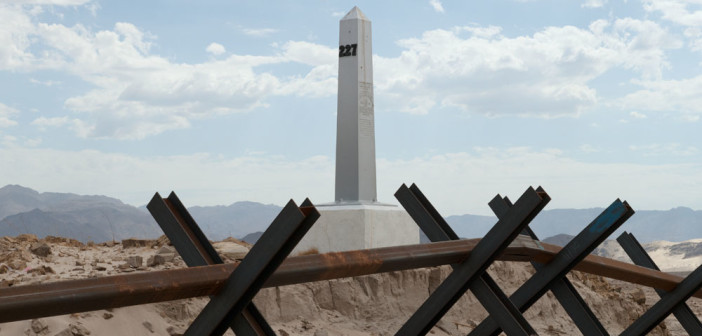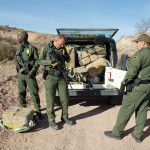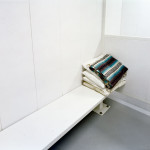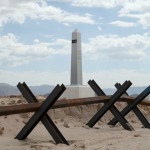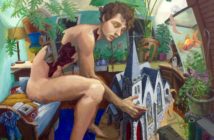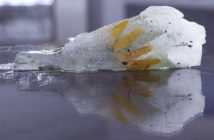Taylor’s Working the Line pairs a careful topological survey of the 276 border monuments that dot the international boundary every 2-3 miles west of the Rio Grande with more intimate documentary photographs of the people he has met during his travels. We attended the opening on February 26, when Taylor and curator Michelle Lamunière gave a guided tour of the exhibition, on view now through May 18 at the David Rockefeller Center for Latin American Studies. Both shared stories of the personal and political history (not to mention, art history) behind this work along with insights gleaned from the ground. The details are important. That white foam in The New River, 2009? It’s effluent, the runoff from industrial and agricultural facilities, in which immigrants immerse themselves to seek cover from the border patrol. Those BackPack Scars, 2009? They were worn into the young man’s backside over miles of travel by the same abrasive burlap material that packages Seized Marijuana Bales, AZ, 2009. He is one of many smugglers, traffickers, and migrants alike who journey 30-60 miles across desert terrain to cross the border. Each year, 200-300 of them will succumb to the harsh climate.
 David Taylor, Border Monument No. 227, 2009. Archival inkjet print. Courtesy of James Kelly Contemporary.
David Taylor, Border Monument No. 227, 2009. Archival inkjet print. Courtesy of James Kelly Contemporary.Taylor is a storyteller. He travelled those same trails, meeting the people who work both sides of the US-Mexico border. His photography is divided, similarly, between documentation of the line, those shared obelisks engraved with English and Spanish, and the work, whether legal or illegal, of those who populate the region. Made of iron and stone, the obelisks sometimes disappear (their materials are of value, after all), only to be replaced. They are a perpetual symbol of the great divide, one that Taylor could not resist. But while he began his project with the methodology of D.R. Payne in mind, a photographer who meticulously documented the original border markers of the International Boundary Commission in the late 19th century, Taylor’s heart would soon lead him down different paths. His obvious compassion and deep interest in the lives of others (apparent to anyone who speaks with him, as I can testify) transformed Taylor’s work from a photographic revisitation of those Western landscapes to a wider artistic scope that looks in every direction along the border. Taylor is, first and foremost, a humane photographer whose artwork is imbued with his sociopolitical commitments, which he does not hide from anyone, least of all the border police. His project is less about monuments and more about humanity writ large.
What is most interesting about Taylor’s process is that he gains admittance and access to scenes, events, and people that are off-limits for traditional journalists. As Taylor explains it, being an artist and professor of photography, he falls within a socially predefined category that is innocuous and acceptable to patrolmen and smugglers alike. He is able to gain his subject’s confidence through his identity and, I’m sure, his gentle personality. Though he is watched warily by the two men in Smugglers, Sonora, 2009, they nevertheless let this professor take their portrait (which they then ask to see). This kind of collaboration and interaction informs all of Taylor’s work. His eye is not a harsh or critical one, though his politics are clear-sighted, and his subjects need not be ill at ease about just where their images might turn up.
 David Taylor, Seized Marijuana Bales, Arizona, 2009. Archival inkjet print. Courtesy of James Kelly Contemporary.
David Taylor, Seized Marijuana Bales, Arizona, 2009. Archival inkjet print. Courtesy of James Kelly Contemporary.Taylor compares his persistent documentation of the border obelisks to the work of Bernd and Hilla Becher, but I think he does them one better in his careful and caring attention to the changing landscape, his real subject. It is that landscape and its people, both products of the other, that motivates him. Taylor’s concern is lived experience, first. The lives he documents are lived under some of the most punishing geopolitical constraints. His photographs are witness to those problems--draconian immigration laws, trafficking, drugs, crushing poverty--but they are not about those problems. Rather, they are about human beings trying to better their lives, or simply survive, not abstractions.
That is what makes Working the Line so compelling. Lamunière has a sharp editorial eye. Her curation has helped Taylor tell a profound and poignant story about the people who work and live along the fraught line between the US and Mexico. In Taylor’s photography, we see all too clearly the painful realities cast by the long shadow of the Border Security Industrial Complex.
David Taylor: Working the Line is on view at the David Rockefeller Center for Latin American Studies through May 18.

